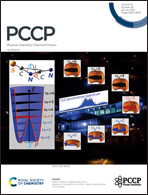Two-dimensional MBene: a comparable catalyst to MXene for effective CO2RR towards C1 products†
Abstract
Electrochemical CO2 reduction reaction (CO2RR) to high-value-added products is one of the most promising strategies for mitigating the greenhouse effect and energy shortage. Two-dimensional (2D) MXene materials are regarded as promising catalysts for electrocatalysis, and the boron-analogs of MXenes, 2D transition metal borides (MBenes), may exhibit superior CO2RR performance owing to their unique electronic properties. Herein, a novel 2D transition metal boride, MoB, is theoretically evaluated as a potential catalyst for the CO2RR by comparing it with traditional Mo2C. MoB shows metallic nature and exhibits excellent electrical conductivity. MoB can effectively activate CO2 with a larger interaction energy of −3.64 eV than that of Mo2C. Both density of states and charge difference density reveal a significant charge transfer from MoB to CO2. MoB shows higher catalytic selectivity due to its inhibited hydrogen evolution reaction and low reaction energy for the CO2RR. At potentials more negative than −0.62 V, the CO2RR on MoB becomes a high-throughput reaction process towards CH4. This work discovered that MoB exhibited comparable CO2RR performance to Mo2C and forecasted MBenes as promising catalysts for electrocatalysis.



 Please wait while we load your content...
Please wait while we load your content...